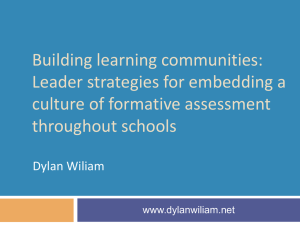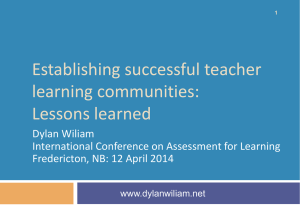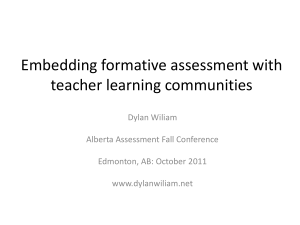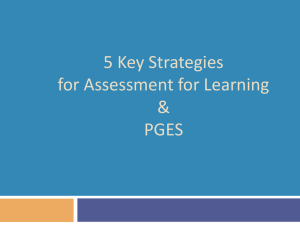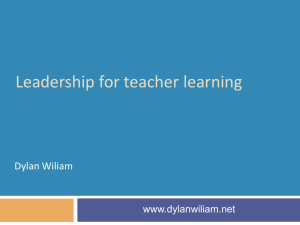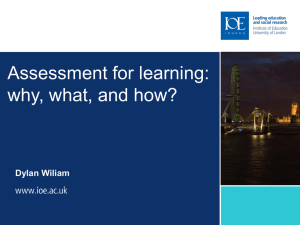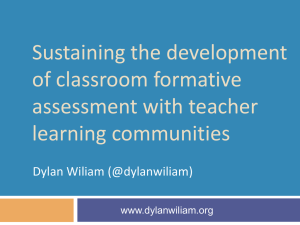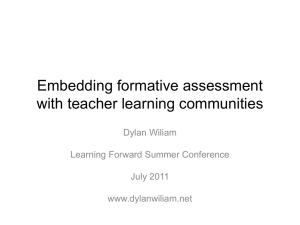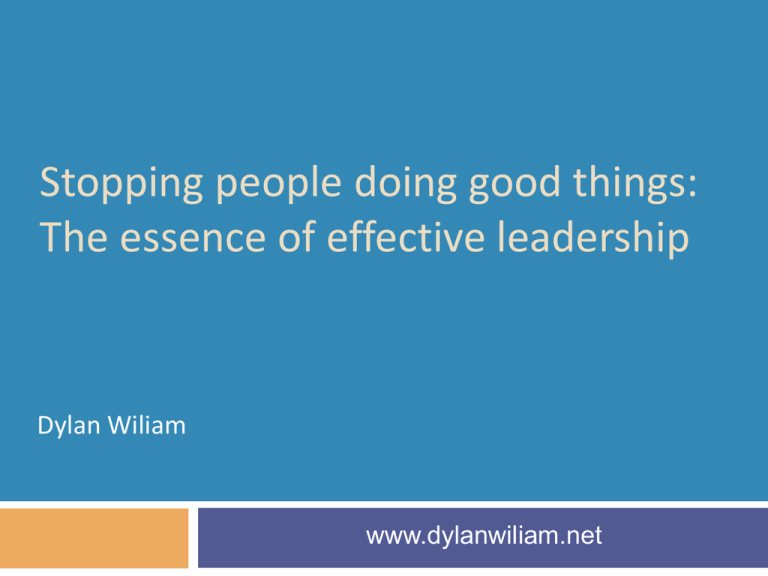
Stopping people doing good things:
The essence of effective leadership
Dylan Wiliam
www.dylanwiliam.net
How do we improve teacher quality?
A classic labour force issue with two (nonexclusive) solutions:
Replace
existing teachers with better ones.
Help existing teachers become even more effective.
Here’s what we know about teaching
3
We don’t know who will be good teachers
We can’t tell good teaching:
when
we see it
by looking at “value-added” test scores
The ‘dark matter’ of teacher quality
4
Mathematics
Primary
Middle
Reading
High
Primary
Middle
—
—
+
General theory of
education courses
Teaching practice
courses
Pedagogical
content courses
Advanced
university courses
Aptitude test
scores
Harris and Sass (2007)
+
High
+
—
—
+
Observations and teacher quality
5
Percentage change in rate of learning
Reading
20
15
Mathematics
So, the highest rated teachers are 30%
more productive than the lowest rated
10
5
0
-5
But the best teachers are 400% more
productive than the least effective
-10
-15
Unsatisfactory
Basic
Proficient
Distinguished
Sartain, Stoelinga, Brown, Luppescu, Matsko, Miller, Durwood, Jiang, and Glazer (2011)
So what’s to be done?
Expertise
7
Grandmaster chess players don’t have higher IQs
than average chess players
Top surgeons don’t have higher IQs, medical school
grades, or higher manual dexterity than average
surgeons
In general, measures of general ability account for
4% of the variability in performance
The role of deliberate practice
8
Music professors at the Hochschule der Kuenst (Academy of
Music) Berlin identified 10 violin students who had the potential
for careers as international soloists (“best” students)
The professors also identified a sample of 10 good, but not
outstanding students (“good” students)
Researchers recruited another 10 students training to be music
teachers who specialised in the violin (“Music Ed” students)
An additional 10 middle-aged professional violinists from two
local orchestras were recruited to the study
Groups were matched in sex (7f, 3m) and for the first three
groups, age
How much do violinists practice?
Music Ed
Good
Best
Professionals
Hours of practie per week
35
30
25
20
15
10
5
0
4
9
14
Age
Ericsson, Krampe, and Tesch-Römer (1993)
19
Violinists’ hours of practice (cumulative)
10
Cumulative hours of practice
Music Ed
Good
Best
10
12
Age
Professionals
10000
8000
6000
4000
2000
0
4
6
8
14
16
18
20
These differences are substantial…
11
Hours of practice by age 18
Music Education students
3420
Good violin students
Best violin students
Professional musicians
5301
7410
7336
By the age of 18, the best violinists have accumulated 40%
more practice than good violinists
Since the amount of deliberate practice being undertaken
by the best students once they are adults is close to the
maximum possible, it is, essentially, impossible for the
good students to catch up to the best.
Talent is over-rated…
12
General conclusions about expertise
13
Elite performance is the result of at least a decade of
maximal efforts to improve performance through an
optimal distribution of deliberate practice
What distinguishes experts from others is the
commitment to deliberate practice
Deliberate practice is
an effortful activity that can be sustained only for a limited
time each day
neither motivating nor enjoyable—it is instrumental in
achieving further improvement in performance
Effects of experience in teaching
14
Extra months per year o f learning
1
Mathematics
1
0
0
-1
-1
-2
-2
-3
-3
-4
-4
-5
Years of teaching experience
0
1
2
3 to 5
Rivkin, Hanushek and Kain (2005)
Reading
-5
0
Years of teaching experience
1
2
3 to 5
Implications for education systems
Pursuing a strategy of getting the “best and brightest”
into teaching is unlikely to succeed
Currently all teachers slow, and most actually stop,
improving after two or three years in the classroom
Expertise research therefore suggests that they are
only beginning to scratch the surface of what they are
capable of
What we need is to persuade those with a real passion
for working with young people to become teachers,
and to continue to improve as long as they stay in the
job.
So what should teachers improve?
Formative assessment…
17
Fuchs & Fuchs (1986)
Elshout-Mohr (1994)
Natriello (1987)
Brookhart (2004)
Crooks (1988)
Allal & Lopez (2005)
Bangert-Drowns et al. (1991)
Köller (2005)
Kluger & DeNisi (1996)
Brookhart (2007)
Black & Wiliam (1998)
Wiliam (2007)
Nyquist (2003)
Hattie & Timperley (2007)
Dempster (1991, 1992)
Shute (2008)
Unpacking classroom formative assessment
18
Where the
learner is going
Teacher
Peer
Learner
Clarifying,
sharing and
understanding
learning
intentions
Where the learner is How to get there
Providing
Engineering effective
discussions, tasks, and feedback that
moves learners
activities that elicit
forward
evidence of learning
Activating students as learning
resources for one another
Activating students as owners
of their own learning
So much for the easy bit
A model for teacher learning
20
Content, then process
Content (what we want teachers to change):
Evidence
Ideas
Science
(strategies and techniques)
Process (how to go about change):
Choice
Flexibility
Small
steps
Accountability
Support
Design
Choice
A strengths-based approach to change
22
Belbin inventory (Management teams: Why they
succeed or fail):
Eight team roles (defined as “a tendency to behave, contribute
and interrelate with others in a particular way”):
Key ideas:
Company worker; innovator; shaper; chairperson; resource
investigator; monitor/evaluator; completer/finisher; team worker
People rarely sustain “out-of-role” behaviour, especially under stress
Each role has strengths and allowable weaknesses
Each teacher’s personal approach to teaching is similar:
Some teachers’ weaknesses require immediate attention
For most, however, students benefit more from the
development of teachers’ strengths
Flexibility
Strategies vs. techniques
24
Distinguish between strategies and techniques:
Strategies
define the territory of formative assessment
(no-brainers)
Teachers are responsible for choice of techniques:
Allows
for customization; caters for local context
Creates ownership; shares responsibility
Key requirements of techniques:
They
embody the deep cognitive and affective
principles that research shows are important
They are seen as relevant, feasible and acceptable
Small steps
Why is teacher change so slow?
26
Because of the nature of teacher expertise
According to Berliner (1994), experts:
excel mainly in their own domain
develop automaticity for operations needed for their goals
are more sensitive to the task demands and social situations
are more opportunistic and flexible than novices
represent problems in qualitatively different ways than novices
have faster and more accurate pattern recognition capabilities
see richer patterns in the areas of their expertise
begin to solve problems slower but bring richer and more
personal sources of information to bear
Knowing more than we can say
27
Six video extracts of a person delivering
cardiopulmonary resuscitation (CPR):
Five
of the video extracts feature students
One of the video extracts feature an expert
Videos shown to three groups:
students, experts, instructors
Success rate in identifying the expert:
Experts
90%
Students
50%
Instructors 30%
Klein & Klein (1981)
Looking at the wrong knowledge
28
The most powerful teacher knowledge is not explicit:
That’s why telling teachers what to do doesn’t work
What we know is more than we can say
And that is why most professional development has been relatively
ineffective
Improving practice involves changing habits, not adding knowledge:
That’s why it’s hard
And the hardest bit is not getting new ideas into people’s heads
It’s getting the old ones out
That’s why it takes time
But it doesn’t happen naturally:
If it did, the most experienced teachers would be the most productive,
and that’s not true (Hanushek & Rivkin, 2006)
Most of what we do is unconscious
31
Conscious
bandwidth
(in bits/second)
Sensory system
Total bandwidth
(in bits/second)
Eyes
10,000,000
40
Ears
100,000
30
Skin
1,000,000
5
Taste
1,000
1
Smell
100,000
1
Nørretranders, 1998
Hand hygiene in hospitals
Study
Preston, Larson, & Stamm (1981)
Focus
Compliance rate
Open ward
16%
ICU
30%
Albert & Condie (1981)
ICU
28% to 41%
Larson (1983)
All wards
45%
Donowitz (1987)
Pediatric ICU
30%
Graham (1990)
ICU
32%
Dubbert (1990)
ICU
81%
Pettinger & Nettleman (1991)
Surgical ICU
51%
Larson, et al. (1992)
Neonatal ICU
29%
Doebbeling, et al. (1992)
ICU
40%
Zimakoff, et al. (1992)
ICU
40%
Meengs, et al. (1994)
ER (Casualty)
32%
Pittet, Mourouga, & Perneger (1999)
All wards
48%
ICU
36%
Pittet, 2001
Accountability
Making a commitment
34
Action planning:
Forces teachers to make their ideas concrete and creates a record
Makes the teachers accountable for doing what they promised
Requires each teacher to focus on a small number of changes
Requires the teachers to identify what they will give up or reduce
A good action plan:
Does not try to change everything at once
Spells out specific changes in teaching practice
Relates to the five “key strategies” of AFL
Is achievable within a reasonable period of time
Identifies something that the teacher will no longer do or will do
less of
And being held to it
35
“I think specifically what was helpful was the ridiculous NCR [No Carbon
Required] forms. I thought that was the dumbest thing, but I’m sitting
with my friends and on the NCR form I write down what I am going to
do next month.
“Well, it turns out to be a sort of ‘I’m telling my friends I’m going to do
this’ and I really actually did it and it was because of that. It was
because I wrote it down.
“I was surprised at how strong an incentive that was to do actually do
something different…that idea of writing down what you are going to
do and then because when they come by the next month you better
take out that piece of paper and say ‘Did I do that?’…just the idea of
sitting in a group, working out something, and making a commitment…I
was impressed about how that actually made me do stuff.”
—Tim, Spruce Central High School
Support
Supportive accountability
37
What is needed from teachers:
A
commitment to:
The
continual improvement of practice
Focus on those things that make a difference to students
What is needed from leaders:
A
commitment to engineer effective learning
environments for teachers by:
Creating
expectations for continually improving practice
Keeping the focus on the things that make a difference to
students
Providing the time, space, dispensation, and support for
innovation
Supporting risk-taking
Teacher learning communities
39
We need to create time and space for teachers to
reflect on their practice in a structured way, and
to learn from mistakes.
Bransford, Brown & Cocking (1999)
“Always make new mistakes.”
Esther Dyson
“Ever tried. Ever failed. No matter. Try again. Fail
again. Fail better.”
Beckett (1984)
Teacher learning communities
40
Plan that the TLC will run for two years
Identify 10 to 12 interested colleagues:
Conscripts vs. volunteers
Composition:
Similar assignments (e.g., early years, math/science)
Mixed subject/mixed phase
Hybrid
Secure institutional support for:
Monthly workshops (75–120 minutes each, inside or outside
school time)
Time between workshops (two hours per month in school time)
for collaborative planning and peer observation
Any necessary waivers from school policies
A “signature pedagogy” for teacher learning
41
Every monthly TLC workshop should follow the
same structure and sequence of activities:
Activity
1: Introduction (5 minutes)
Activity 2: Starter activity (5 minutes)
Activity 3: Feedback (25–50 minutes)
Activity 4: New learning about formative assessment
(20–40 minutes)
Activity 5: Personal action planning (15 minutes)
Activity 6: Review of learning (5 minutes)
Activities 1, 2, 3, 5, 6: “Bookends”
42
For each of these five activities, the process is
exactly the same at each TLC meeting
This provides a familiar structure for teachers to
get better together
As
the structure fades into the background,
The
learning comes into the foreground
Teachers come to the meeting knowing what is
expected of them
Ground-rules for TLCs
43
Norms of collaboration (Garmston & Wellman,
1999)
Seven powerful Ps
Pausing
Paraphrasing
Probing
Putting
ideas on the table (and pulling them off!)
Paying attention to self and others
Presuming positive intentions
Pursuing a balance between advocacy and inquiry
Activity 1: Introduction
44
Sharing learning intentions for the meeting
Activity 2: Starter
45
A variety of warm-up activities to get participants’
minds to the meeting:
Think of something you are looking forward to this year
30-seconds to get “things off your chest” about what
infuriates you about your job
30 seconds to tell the group about something that
happened within the last month and made you feel good
Think of something that happened in a lesson this year that
made you smile
Think of something that one of your colleagues did last
term that supported you
Go back to the TLC ‘ground rules’
Activity 3: Feedback
46
Routines need to be established, expectations
shared, and structure maintained.
Similar expectations regarding preparation and
engagement.
Come
to the meeting knowing you will be sharing your
own AfL experiences.
Be prepared to offer constructive, thoughtfully
conceived feedback to colleagues.
Be prepared to challenge ideas that may be good
classroom practice but are not necessarily tightly
related to formative assessment.
Activity 4: New learning about AfL
47
Drip-feed’ of new ideas, to increase knowledge,
and to produce variety
Watch
videos of classroom practice
Book study (one chapter each month)
New AfL techniques
Activity 5: Personal action planning
48
Each teacher updates his or her personal action
plan
Makes a specific commitment about what they will
do over the coming month
Arranges any support needed from colleagues
Specific
date and time for peer observation
Activity 6: Wrap
49
Did the meeting meet its intended objectives
If
yes, great
If no, time to plan what to do about it
Every TLC needs a leader
50
The job of the TLC leader(s):
To
ensure that all necessary resources (including
refreshments!) are available at workshops
To ensure that the agenda is followed
To maintain a collegial and supportive environment
But most important of all:
It
is not to be the formative assessment “expert”
Peer observation
51
Run to the agenda of the observed, not the
observer:
Observed
e.g.,
teacher specifies focus of observation:
teacher wants to increase wait time
Observed
Provides
Observed
teacher specifies what counts as evidence:
observer with a stopwatch to log wait times
teacher owns any notes made during the
observation
Summary
52
Raising achievement is important
Raising achievement requires improving teacher
quality
Improving teacher quality requires teacher
professional development
To be effective, teacher professional development
must address:
What teachers do in the classroom
How teachers change what they do in the classroom
Classroom formative assessment + teacher learning
communities:
A point of (uniquely?) high leverage
To find out more…
www.dylanwiliam.net
Thank you


